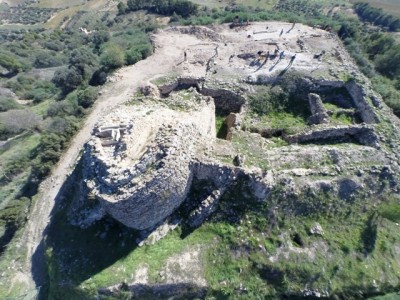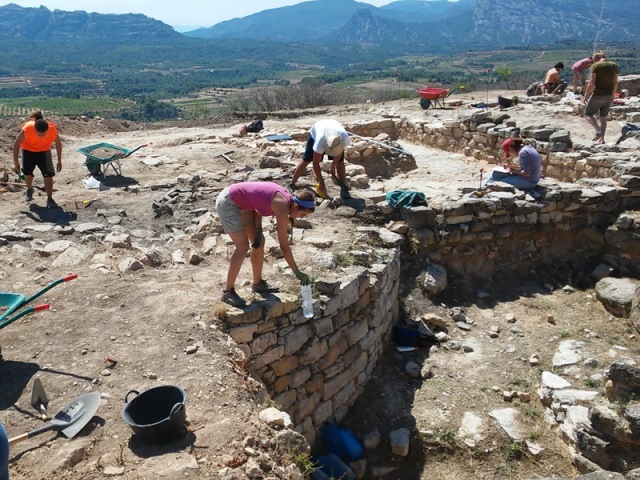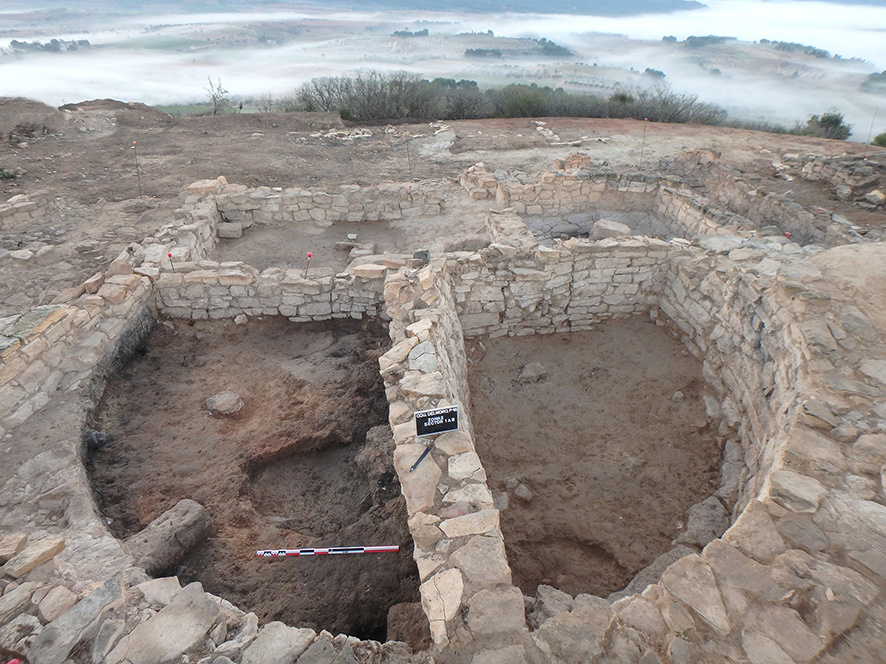

J. Noguera
Archaeological fieldwork started this week on the Coll del Moro archaeological site (Gandesa, Tarragona), a fortified Iberian settlement of about 3,350 meters from the ilercavones tribe, located in the municipality of Gandesa and part of the Iberian Route.
In the 2020 campaign (from June 17 to July 10), there will be interventions in two areas of the archaeological site: in the Calars necropolis sector and in the Settlement sector.
Since 2014, a research team from the University of Barcelona and the Catalan Institute of Classical Archaeology have carried out excavation works at this site and have carried out both geophysical and pedestrian surveys, in the habitat area and in the low-lying areas that extend to south and east of the Coll del Moro territory.
Archaeological works are led by Rafel Jornet (UB), Maria Carme Belarte (ICREA-ICAC), Joan Sanmartí (UB), David Asensio (UB), Jordi Morer (UB) and Jaume Noguera (UB). The project also has the collaboration and support of the Gandesa City Council.
Fieldwork under the COVID-19 situation
The planning and organization of the campaign have been affected by the COVID-19 situation, and different measures have been taken to adapt working conditions to the necessary safety and avoid the risks of contagion.
In the first place, the physical presence of archaeologists at the site has been reduced to an essential minimum, and priority has been given to those works that require less personnel to carry them out, such as, for example, the consolidation and restoration of archaeological remains.
In addition, archaeological works have been chosen in those sectors with a proper broad size that allows safe distances to be guaranteed without problems social distance and all safety regulations. One of these areas is the settlement’s cisterns one.
Moreover, all archaeologists have taken a training and information course on the protocol for action in the excavation dealing with COVID-19.
Finally, overnight stays have been minimized. Archaeologists with residence in the site area (Terres de l’Ebre) will stay in their private homes. Those who come from outside the area will stay in the temporary shelter enabled by the City Council of Gandesa, with single rooms and catering service for the meals.
Expected results
Regarding the excavation works in the habitat area, the team plans to finish the excavation of the cistern (started in the 80s) and set the chronological sequence of the different phases of use, which could date back to the 6th century BC until the III-II century BC, and that it seems that it would definitely fill (data that will have to be confirmed or nuanced with the excavation results).
This overlapping of layers of different chronology, in addition, should give relevant information on paleoenvironmental data: we know that the cistern is reduced in size, could this fact be related to a possible decrease in rainfall during the Iron Age? Or is it a conjunctural fact of the settlement’s own urban growth dynamics?
In any case, researchers consider it highly relevant to obtain as much data as possible in a key sector where information on the foundational phase and the abandonment of the settlement will foreseeably be obtained.
A site with a long history of excavations
The archaeological site of the Coll del Moro site is mentioned for the first time by the famous archaeologist and professor of Prehistory at the University of Barcelona, Pere Bosch Gimpera, in 1914. In his unpublished journal of excavations, he describes remains of walls cut out by the construction of the road and ceramic materials, among which Iberian pottery stands out, with and without painted decoration.
However, the first intervention did not take place until 1953, on the occasion of the erection of a commemorative monument in the place of command of General Franco during the Ebro’s battle that was located in the eastern sector of the necropolis and is known as Calars. On that occasion, six burial mounds were excavated in a rescue intervention published by Doctor Salvador Vilaseca in 1954.
In 1971 and 1974 excavation works were promoted from the MNAT (Tarragona Archaeological Museum), under the direction of Manuel Berges and Màrius Ferrer, which focused on the sectors of the necropolis of Calars and Camp Teuler. The exhaustive study of these structures and their materials was the subject of a doctoral thesis by Dr Núria Rafel (University of Lleida), who resumed the archaeological works in the necropolis and the habitat.
The habitat was first excavated between 1972 and 1976, under the direction of Manuel Berges and Màrius Ferrer and, from 1982, with the acquisition of the land for the Generalitat de Catalunya, the planned excavations began, with regular interventions until the early 1990s (in 2006 and 2007, the same team led by Núria Rafel excavated the interior of the tower).

 Coll del Moro site, 2015 campaign
Coll del Moro site, 2015 campaignIn 2014, excavation works were resumed in the archaeological site, within the framework of the research project “The first millennium BC. C. in the territories of the lower Ebro course: the formation, development and dissolution of Iberian culture 2014-2017″, led by the University of Barcelona and with the participation of ICAC.
Until then, interventions (started in the 70s) had focused on the northern area, the area of the tower or fort of Coll del Moro, and on nearby structures, but the habitat was poorly understood. The expansion of the excavation area made it possible to locate the remains of a habitat sector from the 3rd century BC, with numerous vestiges of houses and streets foundations.
The third excavation campaign (2016) led to document a set of structures interpreted as an oil mill from the 3rd century BC, the oldest one in Catalonia, which belongs to the Iberian period and was abandoned around 200 BC. Above that, there is a later phase, Roman-republican, from approximately 125 BC. C.

The latest archaeological works focused on the excavation of the so-called “zone 2″: a set of complex buildings made up of a rectangular body, with different areas and attached to a probable exterior wall. The buildings communicate with each other through apsidal enclosures that probably had a defensive function.
The 2019 excavation campaign (from July 8 to 27) was mainly focused on drawing and documenting structures. The works belonged to a UB-ICAC research project: Formation, development and dissolution of Iberian culture in the lower Ebro (IX-I BC), led by Rafel Jornet (UB – Món Iber ROCS), Maria Carme Belarte (ICREA-ICAC), Jordi Morer (Món Iber ROCS), David Asensio (UB – UAB – Món Iber ROCS) and Joan Sanmartí (UB). With funding from the Department of Culture of the Generalitat de Catalunya and the City Council of Gandesa.
Jornet, R.; Belarte, M. C.; Sanmartí, J.; Asensio, D.; Morer, J.; Noguera, J. (2020): “El Coll del Moro (Gandesa, Tarragona) y su contexto territorial: formación y desarrollo de un asentamiento urbano protohistórico”, Trabajos de Prehistoria 77 (1), 199-215.
Tribuna d’Arqueologia 2018-2019, vídeo de la conferència “Intervencions al jaciment Ibèric de Coll del Moro de Gandesa (Terra Alta) entre 2014 i 2018” (abril de 2019).
Jornet, R.; Belarte, M. C.; Sanmartí i Grego, J.; Asensio, D.; Morer de Llorens, J. (2016): “Noves excavacions al nucli fortificat del Coll del Moro de Gandesa (2014-2015)”, Actes de les I Jornades d’Arqueologia de les Terres de l’Ebre (Tortosa, del 6 al 7 de maig de 2016), p. 345-358.





